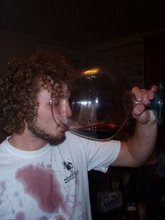Washington may have chopped the cherry tree, but it was Thomas Jefferson who was the first wine geek president. While living in Paris as a diplomat he not only developed his taste for fine wines and foods, Ben Franklin acquired the same habit the same way and both lived into their 80's, but also used his farming skills and brought back vine cuttings from Bordeaux to his home at Monticello in Virginia. Alas, the yet undetected native American vine mite, Phylloxera, destroyed the vines and no wine was ever produced by Jefferson. Eventually this microscopic bug was transported to Europe and ruined most of the vineyards there in the mid 1800's. Surprisingly, today almost all vines are grown on American root stock. Think of Concord underground and Cabernet on top.
With that knowledge today there is a healthy and high quality wine growing region in the Virginian Piedmont. Jefferson would be proud. Unfortunately, these yummy wines rarely are available outside of the Commonwealth of Virginia and the D.C. area. If you live there, you know, but for the rest of us... road trip!
When Jefferson was alive, he enjoyed fine Bordeaux, but the Bordeaux of the 1700's was different than today's Bordeaux. Today, only 5 varieties of grapes are allowed in the blend; Cabernet Sauvignon, Cabernet Franc, Merlot, Petit Verdot and Malbec. Back then there was a 6th grape, think of the 5th Beatle, Carmenere. When the Phylloxera bug hit, the winemakers of Bordeaux allowed the Carmenere to go extinct because the grapes need to hang on the vine for an extra week than all the others. This extra week of ripening was not always reached as the Earth was in a cooling time back then, think of global warming in reverse. Until recent scientific advances, ie. DNA mapping, the way you determined what grapes were growing in your vineyard was the science of Ampelography. No, Ampelography has nothing to do with silicon implants, but rather it is the science of tracing leaf patterns to determine grape varieties, sort of fingerprints for leaves. Unfortunately, the Merlot and the Carmenere have the same pattern, so DNA to the rescue. Today's almost all of the known Carmenere is grown in Chile.
Carmenere is one of the most lovable dry red wines in the world today. When the grape is allowed to hang to ripen perfectly it yields a smooth dry red wine with some fruit and spice and chocolate flavor/aroma sensations. My two favorites are the Vina Chocolain 2007 retailing about 12 a bottle and the luscious Arboleda 2006 around 20 a bottle. They are equally good with steaks as well as roasts and braises of beef or lamb. And I would not be against serving them with a game bird such as goose or duck.
To pronounce Carmenere, try Car man air.
Monday, February 16, 2009
Subscribe to:
Post Comments (Atom)

No comments:
Post a Comment